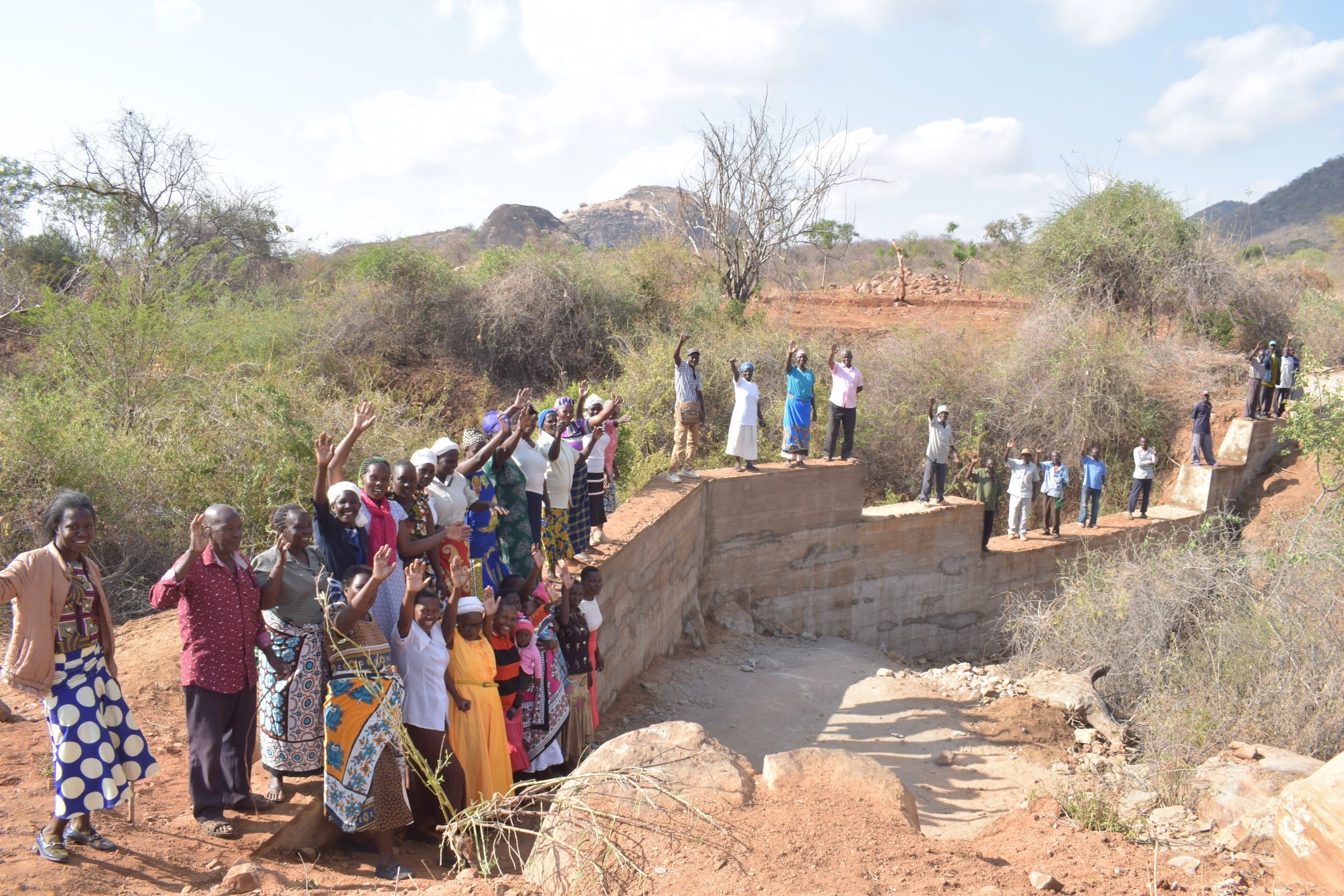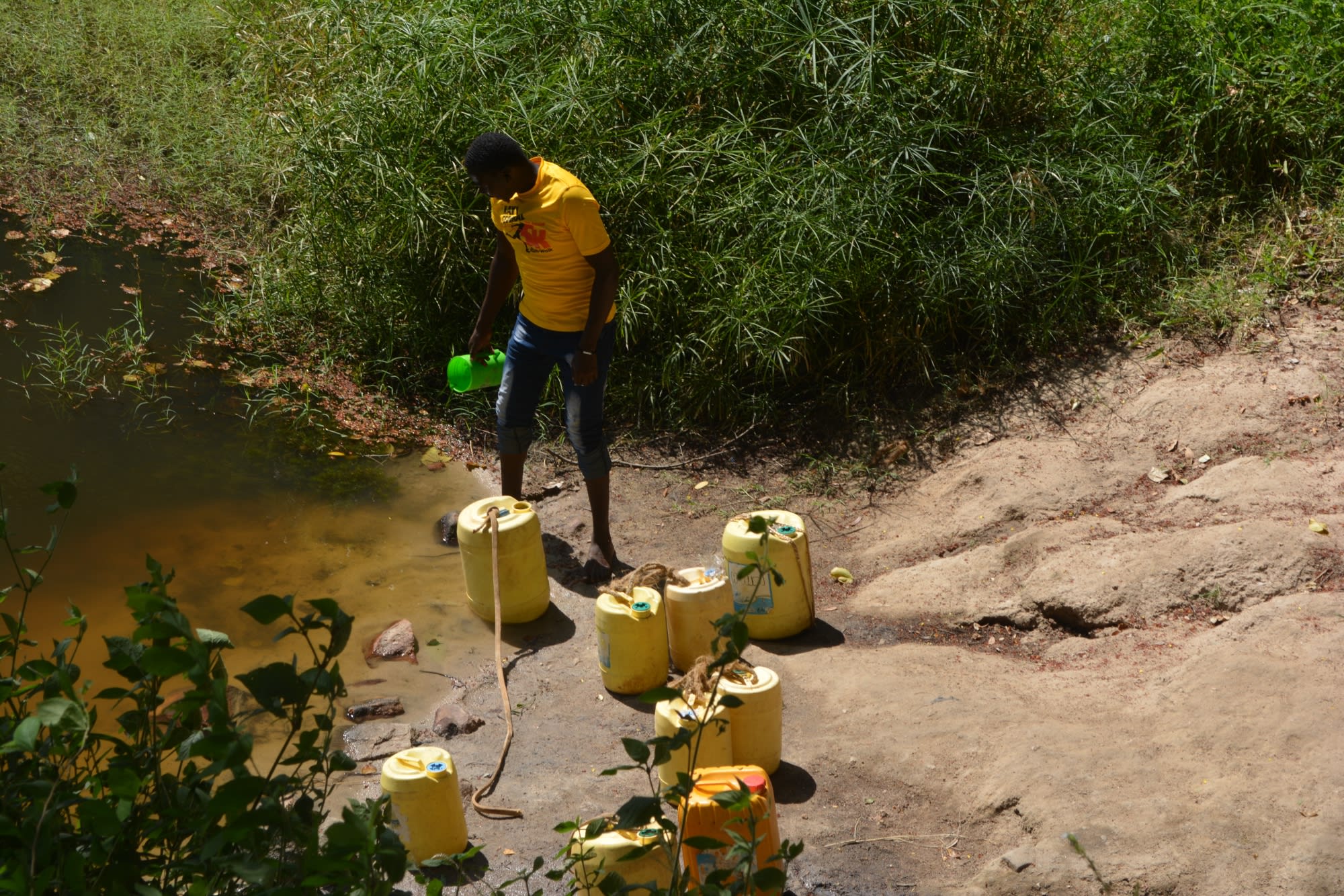Project Updates
July, 2020: Through Their Eyes: COVID-19 Chronicles with Kanyaa Kavindu
This story is a part of a series by The Water Project meant to highlight the perspectives and experiences of the people we serve and how they are being impacted by the COVID-19 pandemic. See other stories in the series here.

Kanyaa Kavindu (center) standing with her husband, son, and grandchildren.
The Kenyan government implemented a series of restrictions to prevent the spread of COVID-19 in the country. A curfew is in place from 9:00 pm to 4:00 am each day, social gatherings are limited, and people are not allowed to move in and out of counties with higher caseloads - including the capital city of Nairobi. As a result, everyday life is significantly disrupted.
For Kanyaa Kavindu, a 57-year-old mother of 7, the changes significantly impact her life. Kanyaa and her husband live in Wamwathi, a community in southeast Kenya. Their elder children live and work in Nairobi. They send home money to their parents but no longer can send as much because their incomes fell as a result of the COVID-19 lockdown. This money is crucial for them because one of their younger children suffers from a health problem that requires extra attention and financial resources.

Kanyaa Kavindu
"It has been difficult taking care of him in such a time with limited financial ability," Kanyaa told our team during a recent visit.
We spoke with Kanyaa as a part of our outreach to communities where we work to understand the impacts of COVID-19 on people's lives. Kanyaa and her husband are members of the Syiluluku Self-Help Group. The members work together to improve their community - notably through projects such as constructing a sand dam and hand-dug well to enable access to safe water every day.
"Our community entirely depends on the shallow well we constructed last year. We have installed a handwashing station at the well to prevent the spread of the virus," Kanyaa said.

Wamwathi community members stand on the sand dam they helped construct last year
Wamwathi Community is in Kitui County of southeast Kenya. It is a semi-arid region that experiences periods of drought – a situation that is only getting worse due to climate change. The households are spread out. Some homes are as far as 2 kilometers apart. Before the construction of the project, community members, including Kanyaa, woke up at 3:00 am to get water from the nearest reliable water point. Now, people can make a short walk to the dam and shallow well they completed instead.
The project is helping the Kavindu family deal with the unique challenges presented by COVID-19. While the money remitted from Nairobi has decreased, the family now has a garden where they grow vegetables - something they did not have before.

"Using water from the well, we have developed a small garden near the water point where we have grown pawpaws, maize, sugarcane, and sweet potatoes. All this supplements the small produce from our farm toward feeding my children and grandchildren here at home," Kanyaa explained.
The sugarcane holds the potential to provide income for the family, too. It takes more than 18 months to mature but it is very lucrative if grown successfully.
During our visit to Wamwathi, our teams conducted a COVID-19 sensitization training. We went over national and international standards for preventing the spread of COVID-19 and refreshed previous training on topics such as handwashing and constructing tippy tap handwashing stations.

COVID-19 sensitization training in Wamwathi
Fortunately, access to water is not a concern for this community anymore.
"The sand dam and shallow projects have been of great importance to us in this time of coronavirus outbreak. The well has been supplying us with clean water since the day it was completed last year," Kanyaa said.
"This has greatly enabled us to practice regular hand washing with clean water since the water is available in plenty."

Handwashing using a tippy tap set up during training

May, 2020: COVID-19 Prevention Training Update at Wamwathi Community
Our teams are working on the frontlines of the COVID-19 pandemic. Join us in our fight against the virus while maintaining access to clean, reliable water.

We are carrying out awareness and prevention trainings on the virus in every community we serve. Very often, our teams are the first (and only) to bring news and information of the virus to rural communities like Wamwathi, Kenya.
We trained community members on the symptoms, transmission routes, and prevention of COVID-19.
Due to public gathering concerns, we worked with trusted community leaders to gather a select group of community members who would then relay the information learned to the rest of their family and friends.
We covered essential hygiene lessons:
- Demonstrations on how to build a simple handwashing station
- Proper handwashing technique
- The importance of using soap and clean water for handwashing
- Cleaning and disinfecting commonly touched surfaces including at the water point.

We covered COVID-19-specific guidance in line with national and international standards:
- Information on the symptoms and transmission routes of COVID-19
- What social distancing is and how to practice it
- How to cough into an elbow
- Alternative ways to greet people without handshakes, fist bumps, etc.
- How to make and properly wear a facemask.

During training, we installed a new handwashing station with soap near the community’s water point.
Due to the rampant spread of misinformation about COVID-19, we also dedicated time to a question and answer session to help debunk rumors about the disease and provide extra information where needed.
Water access, sanitation, and hygiene are at the crux of disease prevention. You can directly support our work on the frontlines of COVID-19 prevention in all of the communities we serve while maintaining their access to safe, clean, and reliable water.

March, 2020: Wamwathi Community Hand-Dug Well Complete!
Wamwathi Community, Kenya now has a new source of water thanks to your donation. A hand-dug well was constructed adjacent to a sand dam (go here to check it out). The dam was constructed on the riverbed, which will build up sand to raise the water table and naturally filter water. Recent rains have already helped the dam begin to build up sand and store water.

"We are very happy as community members in this locality," said Ndungwa Mutisya, a member of the community. "The long distances traveled in search of water will be cut down by the presence of this facility. We are thankful to the donors."
It could take up to 3 years of rain (because sometimes it only rains once a year!) for this sand dam to reach maximum capacity. As the sand dam matures and stores more sand, a supply of water will be available for drinking from the well. With this water, the surrounding landscape will become lush and fertile.
Hand-Dug Well
Construction for this well was a success!

We worked with the Syiluluku Rock Catchment Self-Help Group for this project. The members and their families contributed materials and physical labor to complete the project. In addition, they were trained on various skills such as bookkeeping, financial management, project management, group dynamics, and governance. We also conducted a hygiene and sanitation training to teach skills like soapmaking and to help improve behaviors such as handwashing.
When an issue arises concerning the water project, the group members are equipped with the necessary skills to rectify the problem and ensure it works appropriately. However, if the issue is beyond their capabilities, they can contact our team of field officers to assist them.
Hand-Dug Well Construction Process
We delivered the experts, materials, and tools, but the community helped get an extraordinary amount of work done too. They collected local materials to supplement the project, including sand, stones, and water.

A hole 7 feet in diameter is excavated up to a recommended depth of 25 feet. (Most hand-dug wells do not reach that depth due to the existence of hard rocks between 10-18 ft.).
The diameter shrinks to 5 feet when construction of the hand-dug well lining is completed. This lining is made of brick and mortar with perforations to allow for water to seep through. Sand builds up around the well walls, which will naturally filter the rainwater that is stored behind the dam.

Once the construction of the lining reaches ground level, a precast concrete slab is laid on top and joined to the wall using mortar. 4 bolts for the hand-pump are fixed on the slab during casting. The concrete needs to dry for 2 weeks before the pump is installed. The mechanics arrive to install the pump as community members watch, learning how to manage simple maintenance tasks for themselves.

The well is then given another few days after installing the pump to allow the joints to completely dry. The pump was installed level with the top of the sand dam. As the dam matures, sand will build up to the top of the wall. Until then, people will climb the concrete steps to get their water.
New Knowledge
The training was planned by the sanitation and hygiene officer Veronica Matolo in collaboration with the Waita area field officer Austin Mumo. Austin notified the group on the need to have a hygiene training after completion of the project. A date was agreed and communicated to Veronica for her preparations. All community members were invited for the training as well as village elders and church leaders.

Veronica conferred with the field staff about their previous visits to households and interviews with community members to determine which topics the community still could improve upon. They decided to train on topics including health problems in the community; good and bad hygiene behaviors; how diseases spread and their prevention; choosing sanitation improvements; choosing improved hygiene behaviors; planning for behavioral change; handwashing; and soapmaking.

The training was held at the Apostolic Church grounds under an indigenous tree within the compound. The weather was constantly fluctuating from windy to sunny and sometimes cold. Despite the weather hindrances, the community was flexible enough to adapt to the different situations which created a conducive learning environment.

Nearly all of the group members attended the training. In addition, the church pastor and the village head took part. All attending community members participated actively in the training sessions, though older attendees expressed more interest to learn more concepts compared to younger attendees, observed our team. This was motivated by their strong community ties. They encouraged the younger generations to embrace these development-oriented activities.
Members found the community mapping activity special because they said that it enabled them to understand their area better than they previously knew it. They also said they learned that it was important to have latrines and to keep their homesteads clean.

"We are happy to have been taken through a very educative session which has equipped us with a lot of knowledge. We know the importance of maintaining good hygiene practices for good health and we have learned the disease transmission routes and how to prevent them through handwashing and boiling water," said Ndungwa Mutisya after the training.
Thank you for making all of this possible!

January, 2020: Wamwathi Community hand dug well underway!
A severe clean water shortage at Wamwathi Community drains time, energy, and health from people here. Thanks to your generosity, we’re working to install a clean water point and much more.
Get to know this community through the introduction and pictures we’ve posted, and read about this water, sanitation and hygiene project. We look forward to reaching out with more good news!


 Protected Dug Well
Protected Dug Well
 Rehabilitation Project
Rehabilitation Project








































